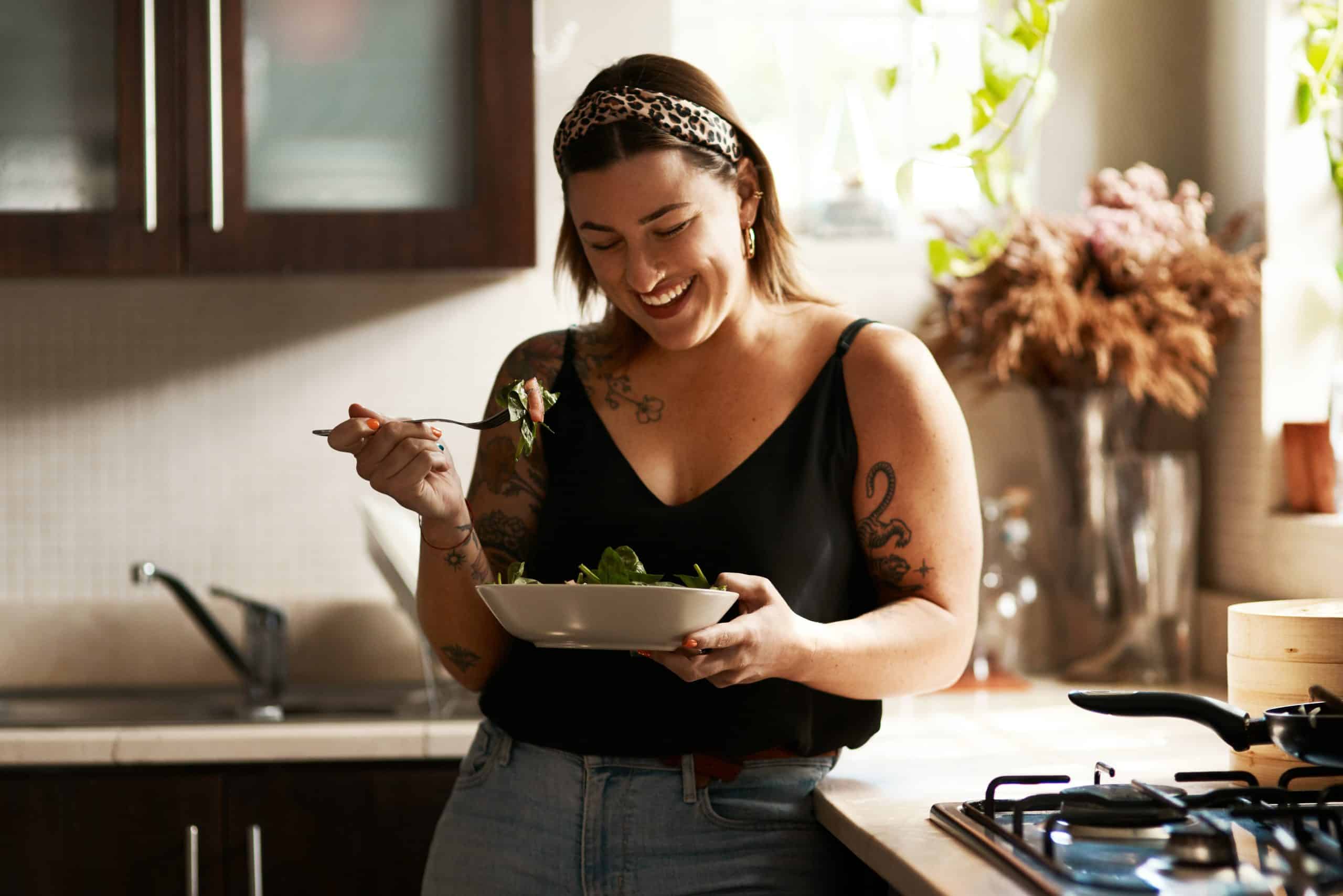The digestion and absorption of fats differ from other micronutrients and vitamins as carbs and proteins are water-soluble, but fats aren’t. Therefore, while the fats are in the digestive tract, they cluster together due to the watery environment, which requires different steps for the body to absorb them into the bloodstream, while carbohydrates directly enter the bloodstream.
Fats and fatty acids must follow a different route in order to be absorbed by the body. They enter the lymphatic system, where they’re absorbed through the lacteals, and as the lymphatic fluid mixes with the fats, the resulting chyle can be transported in the body and absorbed into the bloodstream.
Follow us into the discussion as we look at fat digestion and absorption steps, the causes of poor fat absorption, how we can improve fat absorption, and whether blocking fat absorption affects weight.
What Is Fat Absorption?
Fat that is present in foods is digested and then absorbed. Some of it is used for energy instantly, while some portion of the energy is stored for later. Over 90% of the dietary fat is in the form of triacylglycerol (TAG). The remaining fat is present as cholesterol, phospholipids, cholesteryl esters, and free fatty acids.
The mechanism of fat digestion and absorption includes emulsification and breakdown by bile and the local enzymes in the gastrointestinal system. The amount of time that is taken for the fat to be absorbed in the body varies from person to person. According to the Mayo Clinic, the transit time from eating to eliminating stool is between 2 and 5 days (3).
Generally, fat takes longer to digest than other food items. Dietary fats can consist of:
- Saturated fats
- Monounsaturated fatty acids
- Polyunsaturated fatty acids
- Trans fats
Lean and toned up body isn’t just a far-fetched fantasy. Check out the BetterMe app and watch it propel your weight loss journey into high gear!
Fat Digestion and Absorption Steps
Fats and fatty acids, which are scientifically known as lipids, may be liquid or solid at room temperature. They can be triglycerides, steroids, phospholipids, cholesterol and cholesterol esters, carotenoids, and fat-soluble vitamins such as vitamins A, D, E, and K.
As they’re all fats and oils, they follow the same digestion and absorption steps below.
Digestion begins in the mouth, continues in the stomach, and ends in the small intestines, which is where they are absorbed into the body.
Lipid Digestion in the Mouth
Digestion of lipids starts in the mouth immediately after you consume food. As you chew, there is a mechanical breakdown of fats into smaller particles that mix with saliva. At the same time, the lipase enzyme starts the breakdown of the fats.
Lipid Digestion in the Stomach
When the mixture arrives in the stomach, the stomach also releases an enzyme called gastric lipase to help with digestion. This creates a milky substance called chyme.
Chyme is a lipid emulsion with droplets smaller than 0.5 mm. As they’re much smaller now, they enter the duodenum for further hydrolysis.
Lipid Digestion in the Small Intestine
In the duodenum, its mucosal cells stimulate the hormone cholecystokinin to release bile produced in the liver but stored in the gallbladder. It includes three components during its release: bile salts, cholesterol, and phospholipids.
From the duodenum, digestion proceeds to the jejunum, where the chyme is further broken down by pancreatic lipase. This is another enzyme from the exocrine glands in the pancreas.
Lipid Absorption from the Small Intestine
The bumping of micelles in the small intestines enterocytes causes the micelles to be taken up to the epithelial cells using chylomicrons and then transported into the bloodstream.
These tiny fatty droplets get into transport vehicles called chylomicrons in the golgi of the epithelial cells. Instead of being absorbed directly into the capillary blood, these chylomicrons must first enter the lymphatic vessel.
Finally, the chylomicrons lymph rich with fats drain the monoglycerides into the lymphatic system and they flow into the bloodstream.
Poor Fat Absorption
The gastrointestinal tract is responsible for the digestion and absorption of fats in the body.
When the absorption of fats is impaired at any point in the track, particularly in the intestinal lumen or the brush border of the small intestine enterocytes, malabsorption occurs. Malabsorption is the impaired absorption of fats, among other micronutrients in the small intestines, which is caused by a dysfunction in the gallbladder, pancreas, or small intestine.
Fat malabsorption is one of the most common malabsorption syndromes and has multiple causes (9).
Poor Fat Absorption Causes
Here are the causes of poor fat absorption in the body:
Low pH Value in the Duodenum
The optimal pH value in the duodenum is 6.5 to 7. Any pH value below 6.5 will affect the acidic reaction between chyme and bile acid, causing them to fail in fat digestion. The Zollinger-Ellison syndrome is known to lower pH by destroying pancreatic enzymes used for digestion using stomach acids with a pH of 4.
Lost Absorptive Intestinal Surface Area
Looking at how the micelles are to get into the small intestines enterocytes, they need enough functional surface area. If the small intestine mucosa loses its function, there will be decreased transit time for the fats and less time for digestion. Conditions such as celiac disease, enterocyte disease, Crohn’s disease, and small bowel resection can decrease the absorptive surface area of the intestine.
Impaired Lipid Processing by Bile Acids
In this situation, there’s not enough bile acid secretion to absorb fats and fatty acids fully. This means there is a failure in bile acid synthesis or transport, which can also result from bile acids remaining in the intestinal lumen rather than being absorbed and reused for fat digestion.
Conditions that cause impaired bile acid secretion include liver disease/ hepatic cirrhosis, cholestasis, or an inborn defect that decreases or obstructs bile acid secretion and flow.
Small Intestinal Bacterial Overgrowth (SIBO)
SIBO occurs when there’s an overgrowth of bacteria in the small intestine. When there are too many bacteria in the intestinal lumen, some of them deconjugate bile acids, which renders bile acids ineffective for fat absorption. SIBO can be present in conditions such as atrophic gastritis, use of proton pump inhibitors, IBD, GI stasis, or prolonged lactose deficiency.
Pancreatic Exocrine Insufficiency
An exocrine insufficiency causes a defective production of pancreatic lipase, colipase, and bicarbonate, which means impaired fat digestion. Such an insufficiency is common in patients with pancreatic cancer, pancreatic resection, chronic pancreatitis, cystic fibrosis, gastric surgery, celiac disease, Shwachman-Diamond syndrome, and Zollinger-Ellison syndrome.
Defective Chylomicron/Lipoprotein Secretion
Impaired lipoprotein secretion affects how chylomicrons are packaged and secreted into lymphatics. Defective apoproteins can be from an MTP gene mutation or abetalipoproteinemia.
Lymphatic System Disorders
Lastly, lymphatic disorders stem from either intestinal lymphangiectasia or Whipple’s disease. These conditions cause an impaired lymphatic flow that affects how fat and fatty acids are processed in the body. These conditions may present as diarrhea and weight loss.
Signs and Symptoms of Fat Malabsorption
A disruption in the breakdown and absorption of fats in the body leads to oily stool, also known as steatorrhea. This is the first sign of poor fat absorption. It tends to be foul-smelling, yellowish in color, and frothy or foamy. Other signs and symptoms include:
- Chronic diarrhea
- Abdominal bloating
- Unintentional weight loss
- Foul-smelling, pale, and bulky stool
- Nutrient deficiencies, particularly fat-soluble vitamins
- Indigestion
- Nausea
- Gastrointestinal discomfort
Looking for a way to break the vicious cycle of weight loss and tone up all the jiggly parts? Watch the extra pounds fly off and your muscles firm up with the BetterMe app!
How to Improve Fat Absorption
Here are the ways you can improve fat absorption in your body.
1. Focus on Healthy Fats in Your Diet
Fats are essential in your body for several reasons, including providing a source of energy and allowing for the absorption of fat-soluble vitamins and minerals. Your doctor may recommend that you consume a low-fat diet while the cause of your fat malabsorption is being addressed. If this is the case, you should limit your saturated fats while including a moderate amount of healthy fats in your diet.
By healthy fats, we mean omega-three fatty acids, monounsaturated and polyunsaturated fats. Healthy fats include:
- Avocado
- Seafood rich in omega-three fatty acids such as salmon, tuna, and sardines
- Walnuts
- Peanut or sesame oil
- Flaxseed
- Cold-pressed olive oil
You should avoid saturated and trans fats such as lard, fast food, fried foods, and commercially baked pastries.
2. Improve Your Gut Microbiome Diversity
You may also improve digestion in your intestines by improving your gut microbiome makeup. These are bacteria that are found in the small intestines, some of which may enhance the absorption and digestion of nutrients and fats. Some probiotic strains can affect how bile is metabolized in the gut, which affects how fat will be absorbed.
Some studies have suggested that probiotic supplements or foods such as yogurt, kombucha, and sauerkraut kefir may change the biochemistry of gut microbes in the small intestines (14). Always consult your healthcare provider before you take any supplements or make dietary changes if you’re being treated for fat malabsorption – probiotics may not be an appropriate option for everyone.
3. Take Digestive Enzymes and Nutritional Supplements
Digestive enzymes are those that are secreted by the gallbladder and pancreas. They help with the breakdown of foods, including fats and fatty acids. Crucial digestive enzymes and nutritional supplements that claim to help with fat digestion and absorption include:
- Lipase – this may help with fat digestion
- Ox bile – this also claims to help support fat digestion
You can also get a prescription pancreatic enzyme that will help you digest food better, but its function is to control a side effect of a medical condition. For example, the pancreatic enzyme pancrelipase (Creon, Pancreaze, Zenpep) is given to patients with a medical disease such as pancreatic cysts, cancer, or cystic fibrosis, which affects how the pancreas produces pancreatic lipase for digestion. Talk to your healthcare provider about whether an over-the-counter supplement or a prescription may be beneficial to you.
4. Use Spices
A study on digestion and absorption of fats in rats revealed some compounds that are found in common spices such as ginger, curcumin, piperine, and capsaicin can stimulate bile secretion, which helps with digestion and the absorption of dietary fat (3). It should be noted that this was a study on rats and additional research is required to confirm these results.
Read more: Counting Macros for Weight Loss: Pros, Cons, and How-To (A Beginner’s Guide)
Blocking Fat Absorption for Weight Management
It has been claimed that blocking fat absorption can help with weight management, precisely, weight loss. While this may make sense, there are no real studies on this that reveal side effects except the negative impact of malabsorption.
When the body doesn’t absorb dietary fats, this causes symptoms such as diarrhea and general weight loss, which means you may lose weight, but this is an unhealthy way to lose it and can cause severe health issues.
There are healthier options, so you don’t need to worry about adverse side effects. In addition, fats provide the body with energy and are essential for the proper absorption of fat-soluble nutrients.
What Foods Prevent the Absorption of Fat?
- Apples. They contain pectin, which is a complex fiber that may block cholesterol absorption and can reduce low-density lipoprotein (12).
- Soy foods. Soybeans contain lecithin, which may increase “good” HDL and decrease “bad” LDL cholesterol (4).
- Seaweed. This contains alginate, which is a water-soluble fiber that may prevent fat absorption (1).
- Whole grains. They contain plenty of soluble fiber that might curb the absorption of fat.
- Oolong tea. This tea contains polyphenols that are believed to block fat absorption and boost metabolic rate.
FAQs
Can fasting burn fat?
Yes, fasting has the potential to burn fat. It involves restricting food intake so your body needs to tap into its fat reserves. Although glucose is an important fuel for the body, you start to use fat for energy when no glucose is left in the body (15)..
It’s essential to understand that not all modes of intermittent fasting are suitable for everyone. For example, intermittent fasting 19/5 plans can be too extreme for beginners. You should consult your healthcare provider before you start a fasting regimen, particularly if you have any medical conditions or are taking any medications.
Can you feel fat burning?
Unfortunately, you can’t feel the fat burning inside the body like you feel muscles burning during a workout. Our bodies are complex biochemical machines. The fat-burning process happens at the cellular level, which is beyond our conscious awareness.
Even though you aren’t feeling the fat burning inside, there are some signs that show your body is burning fat:
- Weight loss
- Clothes fitting more loosely
- Decreasing body fat percentage
It should be noted that these are some potential indicators of the body burning fats. The best way to track progress is to seek help from a registered dietitian. They can help you personalize a fat-burning approach that suits your fitness needs and goals.
Can fat malabsorption cause weight gain?
Fat malabsorption is more likely to cause weight loss than weight gain as it can be difficult to digest and absorb enough calories.
In most cases, fat malabsorption leads to weight loss rather than weight gain. If you’re concerned about your weight or suspect that you have malabsorption, you should consult a healthcare provider for a diagnosis and treatment plan.
What vitamin helps absorb fats?
Small amounts of vitamins are required in your diet to promote health, reproduction, and growth. Vitamins A, D, E, and K are generally considered fat-soluble vitamins as they’re soluble in organic solvents. They are absorbed and transported in a similar way to that of fats (6).
No single vitamin can be pin-pointed as a fat-absorbing vitamin. Fats typically help vitamins to be absorbed, not the other way around. Following a balanced dietary pattern that is rich in healthy fats, whole grains, lean proteins, fruits, and vegetables can help ensure your body has all the necessary nutrients to support adequate fat metabolism and utilization.
The Bottom Line
Unlike the absorption of carbs, proteins, vitamins, and minerals, fat absorption is a complex process. However, this doesn’t mean your body doesn’t need to absorb fat and manage weight. If you think you’re having trouble digesting or absorbing fats, you should talk to your healthcare provider.
DISCLAIMER:
This article is intended for general informational purposes only and does not serve to address individual circumstances. It is not a substitute for professional advice or help and should not be relied on for making any kind of decision-making. Any action taken as a direct or indirect result of the information in this article is entirely at your own risk and is your sole responsibility.
BetterMe, its content staff, and its medical advisors accept no responsibility for inaccuracies, errors, misstatements, inconsistencies, or omissions and specifically disclaim any liability, loss or risk, personal, professional or otherwise, which may be incurred as a consequence, directly or indirectly, of the use and/or application of any content.
You should always seek the advice of your physician or other qualified health provider with any questions you may have regarding a medical condition or your specific situation. Never disregard professional medical advice or delay seeking it because of BetterMe content. If you suspect or think you may have a medical emergency, call your doctor.
SOURCES
- Alginate (2012, ncbi.nlm.nih.gov)
- Bile Acid Malabsorption (n.d., my.clevelandclinic.org)
- Digestion: How long does it take? (n.d., mayoclinic.org)
- Everything you need to know about Lecithin (2017, medicalnewstoday.com)
- Fat absorption and digestion in spice-pretreated rats (2011, onlinelibrary.wiley.com)
- Fat-Soluble Vitamins (n.d., ncbi.nlm.nih.gov)
- Intestinal lipid absorption (2009, ncbi.nlm.nih.gov)
- L Carnitine (2018, WebMD.com)
- Malabsorption Syndromes (2021, ncbi.nlm.nih.gov)
- Orlistat (2007, Sciencedirect.com)
- Papaya preparation (Caricol®) in digestive disorders (2013, pubmed.Nih.gov)
- Pectin (2019, WebMD.com)
- Prescription medication to treat overweight and obesity (2016, middle.nih.gov)
- Probiotics affect metabolism ( 2008, sciencedaily.com)
- Physiology, Glucose Metabolism (2023, ncbi.nlm.nih.gov)
- Steatorrhea (2020, ncbi.nlm.nih.gov)
- Structured Lipids improve fat absorption (2000, academic.oup.com)
- The importance of fats (1998, Sciencedirect.com)
- Vinegar (2006, ncbi.nlm.nih.gov)










